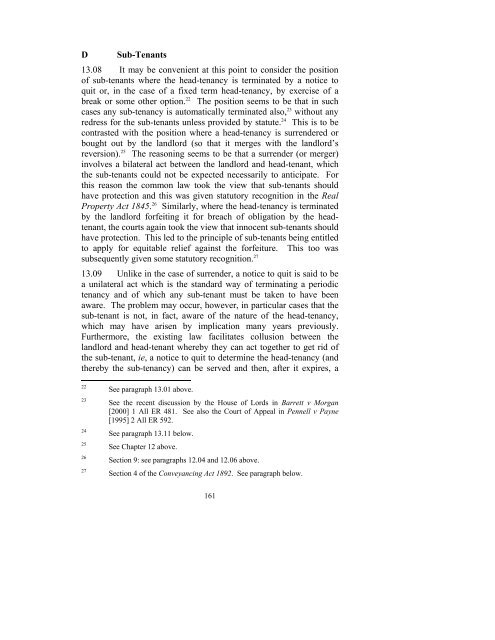Consultation Paper on the General Law of the Landlord and Tenant
Consultation Paper on the General Law of the Landlord and Tenant
Consultation Paper on the General Law of the Landlord and Tenant
You also want an ePaper? Increase the reach of your titles
YUMPU automatically turns print PDFs into web optimized ePapers that Google loves.
D Sub-<strong>Tenant</strong>s13.08 It may be c<strong>on</strong>venient at this point to c<strong>on</strong>sider <strong>the</strong> positi<strong>on</strong><strong>of</strong> sub-tenants where <strong>the</strong> head-tenancy is terminated by a notice toquit or, in <strong>the</strong> case <strong>of</strong> a fixed term head-tenancy, by exercise <strong>of</strong> abreak or some o<strong>the</strong>r opti<strong>on</strong>. 22 The positi<strong>on</strong> seems to be that in suchcases any sub-tenancy is automatically terminated also, 23 without anyredress for <strong>the</strong> sub-tenants unless provided by statute. 24 This is to bec<strong>on</strong>trasted with <strong>the</strong> positi<strong>on</strong> where a head-tenancy is surrendered orbought out by <strong>the</strong> l<strong>and</strong>lord (so that it merges with <strong>the</strong> l<strong>and</strong>lord’sreversi<strong>on</strong>). 25 The reas<strong>on</strong>ing seems to be that a surrender (or merger)involves a bilateral act between <strong>the</strong> l<strong>and</strong>lord <strong>and</strong> head-tenant, which<strong>the</strong> sub-tenants could not be expected necessarily to anticipate. Forthis reas<strong>on</strong> <strong>the</strong> comm<strong>on</strong> law took <strong>the</strong> view that sub-tenants shouldhave protecti<strong>on</strong> <strong>and</strong> this was given statutory recogniti<strong>on</strong> in <strong>the</strong> RealProperty Act 1845. 26 Similarly, where <strong>the</strong> head-tenancy is terminatedby <strong>the</strong> l<strong>and</strong>lord forfeiting it for breach <strong>of</strong> obligati<strong>on</strong> by <strong>the</strong> headtenant,<strong>the</strong> courts again took <strong>the</strong> view that innocent sub-tenants shouldhave protecti<strong>on</strong>. This led to <strong>the</strong> principle <strong>of</strong> sub-tenants being entitledto apply for equitable relief against <strong>the</strong> forfeiture. This too wassubsequently given some statutory recogniti<strong>on</strong>. 2713.09 Unlike in <strong>the</strong> case <strong>of</strong> surrender, a notice to quit is said to bea unilateral act which is <strong>the</strong> st<strong>and</strong>ard way <strong>of</strong> terminating a periodictenancy <strong>and</strong> <strong>of</strong> which any sub-tenant must be taken to have beenaware. The problem may occur, however, in particular cases that <strong>the</strong>sub-tenant is not, in fact, aware <strong>of</strong> <strong>the</strong> nature <strong>of</strong> <strong>the</strong> head-tenancy,which may have arisen by implicati<strong>on</strong> many years previously.Fur<strong>the</strong>rmore, <strong>the</strong> existing law facilitates collusi<strong>on</strong> between <strong>the</strong>l<strong>and</strong>lord <strong>and</strong> head-tenant whereby <strong>the</strong>y can act toge<strong>the</strong>r to get rid <strong>of</strong><strong>the</strong> sub-tenant, ie, a notice to quit to determine <strong>the</strong> head-tenancy (<strong>and</strong><strong>the</strong>reby <strong>the</strong> sub-tenancy) can be served <strong>and</strong> <strong>the</strong>n, after it expires, a222324252627See paragraph 13.01 above.See <strong>the</strong> recent discussi<strong>on</strong> by <strong>the</strong> House <strong>of</strong> Lords in Barrett v Morgan[2000] 1 All ER 481. See also <strong>the</strong> Court <strong>of</strong> Appeal in Pennell v Payne[1995] 2 All ER 592.See paragraph 13.11 below.See Chapter 12 above.Secti<strong>on</strong> 9: see paragraphs 12.04 <strong>and</strong> 12.06 above.Secti<strong>on</strong> 4 <strong>of</strong> <strong>the</strong> C<strong>on</strong>veyancing Act 1892. See paragraph below.161
















